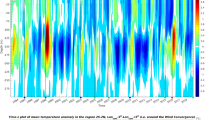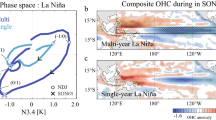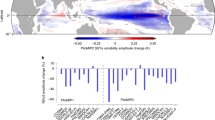Abstract
The role of the Madden–Julian oscillation—a global atmospheric wave in the tropics that is associated with convective activity and propagates eastwards with a period of about 30–60 days (refs 1, 2)—in triggering El Niño events has been discussed before3,4,5,6,7,8. But its possible connection with a termination of El Niño has yet to be investigated, despite the difficulty in explaining the timing of El Niño terminations by the basic wind-induced oceanic-wave processes9,10. For the extreme 1997–98 event, the mechanism of both onset and termination have been investigated3, but the reason for the abruptness of the termination has yet to be resolved. Here we present global data of precipitation, sea surface temperatures and wind speeds that show a precipitation system associated with an exceptionally strong Madden–Julian oscillation travelling around the Equator in May 1998. The propagation of this atmospheric system was associated with an abrupt intensification of the easterly trade winds over the eastern equatorial Pacific Ocean. Combined with the already shallow equatorial thermocline in the central and eastern Pacific Ocean at that time3, these strong winds provided the triggering mechanism for the observed accelerated ending of the 1997–98 El Niño event.
This is a preview of subscription content, access via your institution
Access options
Subscribe to this journal
Receive 51 print issues and online access
$199.00 per year
only $3.90 per issue
Buy this article
- Purchase on Springer Link
- Instant access to full article PDF
Prices may be subject to local taxes which are calculated during checkout




Similar content being viewed by others
References
Madden,R. A. & Julian,P. R. Detection of a 40–50 day oscillation in the zonal wind in the tropical Pacific. J. Atmos. Sci. 28, 702–708 (1971).
Madden,R. A. & Julian,P. R. Description of global scale circulation cells in the tropics with a 40–50 day period. J. Atmos. Sci. 29, 1109–1120 (1972).
McPhaden,M. J. Genesis and evolution of the 1997–98 El Nino. Science 283, 950–954 (1999).
Nitta,Ts. & Motoki,T. Abrupt enhancement of convective activity and low level westerly wind burst during the onset phase of 1986–87 El Nino. J. Meteorol. Soc. Jpn 65, 497–506 (1987).
Nitta,Ts. Development of a twin cyclone and westerly wind bursts during the initial phase of 1986–87 El Nino. J. Meteorol. Soc. Jpn 67, 677–681 (1989).
Nitta,Ts., Mizuno,T. & Takahashi,K. Multi-scale convective systems during the initial phase of 1986/87 El Nino. J. Meterol. Soc. Jpn 70, 317–335 (1992).
Kindle,J. C. & Phoebus,P. A. The ocean response to operational westerly wind bursts. J. Geophys. Res. 100, 4893–4920 (1995).
Lau,K. M. & Chan,P. H. The 40–50 day oscillation and the El Niño/Southern Oscillation: A new perspective. Bull. Am. Meteorol. Soc. 67, 533–534 (1986).
Suarez,M. J. & Schopf,P. S. A delayed action oscillator for ENSO. J. Atmos. Sci. 45, 3283–3287 (1988).
Battisti,D. S. Dynamics and thermodynamics of a warming event in a coupled tropical atmosphere-ocean model. J. Atmos. Sci. 45, 2889–2919 (1988).
Wentz,F. J. & Spencer,R. W. SSM/I rain retrievals within a unified all-weather ocean algorithm. J. Atmos. Sci. 55, 1613–1627 (1998).
Shibata,A., Imaoka,K., Kachi,M. & Murakami,H. SST observation by TRMM Microwave Imager aboard Tropical Rainfall Measuring Mission. Umi no Kenkyu 8, 135–139 (1999). (In Japanese.)
Harrison,D. E. & Vecchi,G. A. On the termination of El Niño. Geophys. Res. Lett. 26, 1593–1596 (1999).
Matsuno,T. Quasi-geostrophic motions in the equatorial area. J. Meteorol. Soc. Jpn 44, 25–43 (1966).
Gill,A. E. Some simple solutions for heat-induced tropical circulation. Q. J. R. Meteorol. Soc. 106, 447–462 (1980).
Wang,B. & Rui,H. Synoptic climatology of transient tropical intraseasonal convection anomalies: 1975–1985 Meteorol. Atmos. Phys. 44, 43–61 (1990).
Wang,B. & Xie,X. Low-frequency equatorial waves in vertically sheared zonal flow. Part I: Stable waves. J. Atmos. Sci. 53, 449–467 (1996).
Slingo,J. M. et al. Intraseasonal oscillations in 15 atmospheric general circulation models: results from an AMIP diagnostic subproject. Clim. Dyn. 12, 325–357 (1996).
Acknowledgements
We thank T. Nakazawa, Y. Suzuki, H. Fujinami, K. Imaoka and H. Murakami for help with processing the SSM/I and TRMM data.
Author information
Authors and Affiliations
Rights and permissions
About this article
Cite this article
Takayabu, Y., Iguchi, T., Kachi, M. et al. Abrupt termination of the 1997–98 El Niño in response to a Madden–Julian oscillation. Nature 402, 279–282 (1999). https://doi.org/10.1038/46254
Received:
Accepted:
Issue Date:
DOI: https://doi.org/10.1038/46254
This article is cited by
-
On the computation of ISO amplitude and frequency indices using a discrete wavelet transform model and application to the study of the annual cycle of ISO activity in Central Africa
Bulletin of Atmospheric Science and Technology (2021)
-
Recent weakening in MJO-related convective activity over the equatorial Indian Ocean and Maritime Continent
Theoretical and Applied Climatology (2021)
-
Ab-initio Study of the Electron Mobility in a Functionalized UiO-66 Metal Organic Framework
Journal of Electronic Materials (2018)
-
Evidence of organized intraseasonal convection linked to ocean dynamics in the Seychelles–Chagos thermocline ridge
Climate Dynamics (2018)
-
Extratropical Forcing Triggered the 2015 Madden–Julian Oscillation–El Niño Event
Scientific Reports (2017)
Comments
By submitting a comment you agree to abide by our Terms and Community Guidelines. If you find something abusive or that does not comply with our terms or guidelines please flag it as inappropriate.



